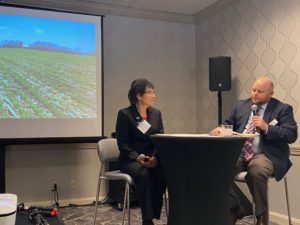Allyship – a buzzword with meaning in agriculture and transportation
By Eric Wenberg, executive director
The Specialty Soya and Grains Alliance (SSGA) is a partner of organizations and member of others. Our set of allies is not a ‘roll the dice’ set of decisions, but rather, alliances that further your aims for successful policies in the identity-preserved (IP) area that will grow your business. You likely belong to many organizations, maybe the Shriners, with their mission to change the future for children and medical needs or the Rotary, building a better world connecting youth. SSGA is your business organization – making the area where you work a better ecosystem. Conservationist Aldo Leopold once said that to save a forest, sometimes you need to cut down trees. SSGA is supposed to make things happen for you and we are moving ahead to do that. Our alliances are part of the picture and SSGA is members of – and partners with – some powerful groups helping us. Rather than just including a set of hyperlinks on our webpage, and since we have the word Alliance in our name, SSGA will occasionally highlight a partner and let you know what we think.
Transportation is key to your future and it’s integral to IP field crops. If you can’t move it, you can’t sell it; add the complexity of the traceability system and you earn the premium you pay farmers and ask buyers to pay you. The Agriculture Transportation Coalition (AgTC), led by Peter Friedmann, is hands down the best operator in this field. SSGA seeks to add value in partnership with AgTC by providing detail and analysis in the specific regions where IP agricultural practices run businesses, and on topics relevant to traceability and push ideas and cooperation up to the ATC. We help sponsor and host AgTC’s regional workshops and follow Peter’s advice about what to do and when to do it with pushing transportation issues ahead.
I also have to give a shout out in this area to Rebuild Rural. This important coalition sponsored by the Farm Credit Council draws together a large network to ensure that rural communities are not left out when Congress or the executive branch talk about improving our infrastructure. These investments have lagged against our competitors and it has to change. Improvements in rail and ports, and making the transportation link work in rural America are key to moving crops from the farm to the table. Why do policy makers not focus on this for us? AgTC and Rebuild Rural help.
I am fond of repeating the African proverb If you want to go fast, go alone. If you want to go far, go together. Choosing our allies defines us, and in transportation we are glad to be helping these two important groups. Our SSGA members on competitive shipping, our ports, freight forwarders and logistics or testing companies are an important component of our organization’s future. Bruce Abbe, our strategic advisor for trade and transportation is always listening and helping SSGA help you. Allyship. The new friendship works for us.




